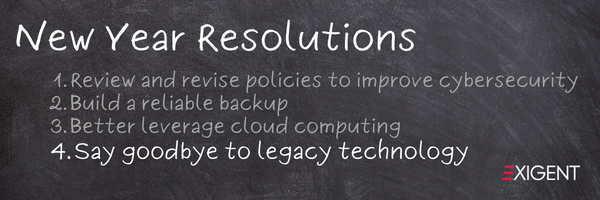The last resolution challenge we will share as we head into 2024 addresses an often-overlooked aspect of cybersecurity: A clear strategy and roadmap for modernizing legacy systems and futureproofing with new tech that bolsters cybersecurity while enabling cloud adoption and your overall digital transformation. A plan for legacy technology replacement should be an integral part of any effort to improve cybersecurity since outdated technology is difficult to secure against today's sophisticated cyber attacks. The security risks of legacy technology include lack of support, patching and alerts from vendors, and aging technology infrastructure that simply can't support modern security solutions.
Key Takeaways
- Outdated tech = high risk: Legacy systems can't support modern security or compliance standards, putting your business at risk.
- Maintenance costs add up: Obsolete hardware drains IT budgets with downtime, inefficiency, and vendor support gaps.
- Modernize for performance and morale: New technology boosts productivity, supports cloud adoption, and attracts top talent.
Legacy Technology Challenges Go Beyond Cybersecurity
While cybersecurity risk is perhaps the most compelling reason for legacy technology replacement planning, there are several drawbacks to relying on legacy IT systems. Obsolete hardware and software bring countless problems to the workplace, from unreliable performance to operating system bugs to compatibility challenges, all while costing more to operate and maintain than modern solutions.
Compatibility: If your network includes end-of-life IT systems, you likely are suffering from interoperability issues. That means, as you add modern technology, you will encounter integration difficulties with legacy systems. Some obsolete technology solutions simply will not work with today's powerful, sophisticated solutions, often lacking the processing speed and storage capacity of contemporary products. That lack creates the need for unstable workarounds and limits the functionality and effectiveness of the investments you are making into new IT solutions.
Maintenance costs: Keeping legacy hardware and software in place may seem to save your organization money, but in reality, the maintenance costs of legacy technology are typically higher. Troubleshooting obsolete technology can be a costly and frustrating undertaking, much like maintaining an antique car or old house. Those expenses must also be examined side-by-side with the lost productivity of employees faced with frequent reboots, systems crashes, slow processing times, corrupted files, and more. Lastly, those old systems typically consume significantly more energy than modern solutions.
Competitiveness: While it may be more difficult to assess, end-of-life technologies can greatly impact your organization's competitive stance in the marketplace, both with customers and talent. Customers in today's fast-paced, "get it in an instant" world have little patience for outages or slow customer experiences. How many of us have seen a sign on the door of a business that read "credit card readers down" and turned around, only to immediately visit another retail option? You can't overlook the impact of revenue and credibility lost in an outage, and we all know there is a nearby rival business with fully functional technology that is happy to serve your customers.
Additionally, when it comes to hiring, polls of workers, particularly younger employees, clearly reflect their desire to work with agile IT infrastructure and innovative tech solutions; they see access to modern technology as a differentiator when making career decisions. Once again, the money saved by avoiding technology investments is probably overshadowed by lost business and the costs of customer and employee churn.
Compliance Challenges with Legacy Systems Dovetail with Cybersecurity Concerns
If your organization is required to meet compliance standards, the impact of obsolete technology can be monumental. Due to the vulnerabilities in unsupported IT solutions, many regulatory compliance standards see end-of-life hardware and software as a huge risk. We could draft an entire book on compliance challenges with legacy systems but suffice it to say that refusing to update obsolete technology that doesn't conform to industry standards means your organization is taking a massive regulatory compliance risk, one that could lead to sanctions, fines, and more.
Compliance in the digital age requires effective, secure IT solutions, which is why legacy systems are considered non-compliant. The probability of data breaches and other cybersecurity attacks with legacy technology is extraordinarily high, particularly as vendor support for that solution ends. Without patches or updates from the product vendor, vulnerabilities go unaddressed, making it easier for hackers to access sensitive, confidential information.
If that isn't enough of a reason, most organizations will find that cyber insurance coverage cannot be secured with obsolete technology in place, for the same reasons. The inability to insure your business can mean facing a cyber attack with no resources, a situation likely to wreak financial and reputational havoc.
Don't Overlook the Impact of Replacement Technology
So, what's a company to do? Commit to an audit of your technology environment—from servers to mobile phones to printers. That evaluation will classify technology into lifecycle buckets, allowing you to plan effectively for replacement technology, addressing both immediate needs and long-term planning. While that initial investment may seem overwhelming, the productivity improvements and operational efficiency gains with modern technology can help offset those costs. Layer in lower maintenance and energy costs, and you might be surprised how quickly you will see a return on investment. While improved cybersecurity can be more difficult to measure, simply taking a moment to consider the impact of a breach or the cost of compliance sanctions should help.
While plotting your strategy, take advantage of your managed IT services partner, who can help you navigate through a plan that will fit your budget while delivering quicker ROI. That MSP will also be able to guide you through data migration from legacy systems to modern solutions, which can be complicated by the compatibility, security, and operational challenges discussed above.
Try to see this as an opportunity to take advantage of the speed, automation, and security of emerging technology, and consider the employee experience gains that come alongside powerful new IT solutions. Ultimately, removing obsolete technology and retiring end-of-life solutions that can create instability and risk within your organization will help deliver better results for your company.
We are happy to answer any questions about cybersecurity or the risk assessment. Simply schedule a consultation with Exigent and let's talk.



